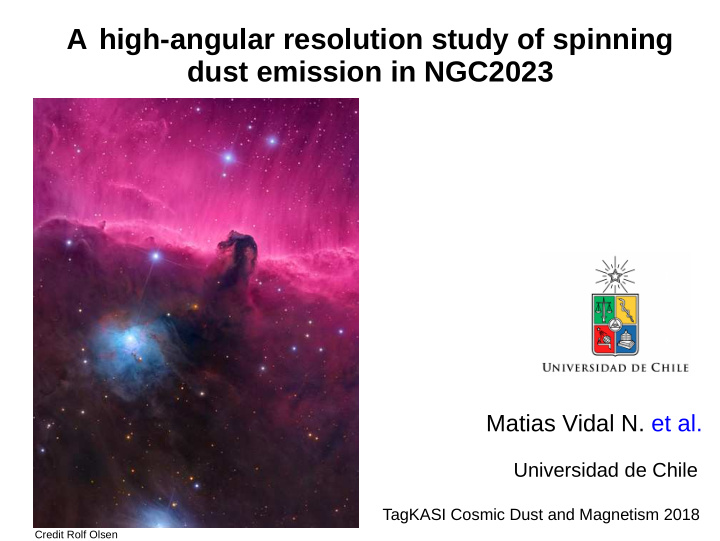



A high-angular resolution study of spinning dust emission in NGC2023 Matias Vidal N. et al. Universidad de Chile TagKASI Cosmic Dust and Magnetism 2018 Credit Rolf Olsen
Anomalous Microwave Emission ● Dust correlated microwave emission. First detected by the COBE mission as a 4σ correlation between maps at 31.5GHz and 140µm (Kogut et al. 1996). ● Much stronger than expected from “normal” dust emission, and with unexpected frequency dependence hence termed Anomalous Microwave Emission (AME). (~30 times larger at 30GHz ) ● It adds to 30% of the Galactic diffuse emission at 30 GHz (Planck 2015 results. X) → apparently more (~50%, QUIJOTE). ● Observed in different environments : ● Molecular clouds ● Transluscent clouds ● HII regions ● Protoplanetary disks ● Other galaxies (NGC 6946, NGC 4725)
Spinning dust ● AME can be explained by spinning dust grains (Draine & Lazarian 1998a,b). ● Very small grains (e.g. PAHs) can get spun up to GHz frequencies by gas collisions, radiative torques, and other processes. ● If grains have a dipole moment, this rotation causes them to radiate. Credit: Yacine Ali-Haïmoud Power radiated given by Larmor formula: And frequency:
Rotational excitation/damping mechanisms ● Collisions with neutrals and ions ● Interaction of charged grain with plasma (“plasma drag”) ● Interaction of grain dipole moment ~µ with plasma ● Absorption of optical photons (electronic transitions) ● Emission of IR photons (vibrational transitions) ● Emission of microwave photons (rotational transitions) ● Emission of photoelectrons ● Formation of H 2 Predicted spectra for different astrophysical environments.
Spinning dust examples Perseus and Orion molecular clouds (Planck early results XX, 2011) Spinning nanodiamonds from the circunstellar disk V892 Tau (Greaves+ 2018, Nature)
Carriers? ● Smaller grains are more suceptible to the spun up/damping mechanisms --> PAHs are an attractive candidate. ● Some AME/PAHs correlation have been observed (Casassus+ 2008; Scaife+ 2010 ) ● As well as lack of correlation in individual clouds: Tibbs+ 11, Vidal+ 11, Battistelli+15 and also full sky: Hensley+ 2016 ● Silicates? It might well be → Hoang+ 2016, Hensley & Draine 2017.
See recent review !!!
NGC 2023 ● Well studied reflection nebula/ edge-on PDR. ● Conspicuous PAH emission. ● Shows Extended Red Emission. ● Central B1.5 star excites the gas and dust. ● 475 pc. Credit: ESO, HLA, Robert Gendler
NGC 2023 mid-IR data ● Well characterized mid-IR emission with Spitzer spectra: PAH, H 2, C 60 ● Complememtary datasets: C-RRL, HCO+, HCN, CN.. Peeters+ 2017
NGC 2023 mid-IR data Clear differences between PAH features. → Have been modeled to trace changes in PAH size, charge and geometry. Peeters+ 2017
NGC 2023 PAH modeling Peeters+ 2017
NGC 2023 PDR conditions ● B type star creates small H II region and further away a C II region. ● C91 α RRL and 8GHz radio continuum ● HCO+ and H 2 rovibrational lines → well characterized physical conditions
NGC 2023 ERE ● First detection of Extended red emission (Gorodetskii & Roshkovskii 1978). ● ERE → Excess of diffuse intensity in the optical R and I bands from reflection nebulae. ● Likely due to luminiscence of carbonaceous nanograins exposed to UV (e.g. Witt+ 2006). ● Does it relates with AME? Unsharped-masked ERE map. Witt and Malin 1989.
VLA observations of NGC 2023 ● Recent VLA observations at K, Ka bands (18 to 36 GHz) and also S band (2 to 4) GHz. ● ≈ 2 arcsec synthesized beam. ● Filamentary emission without counterpart at 3 GHz. 3 GHz
VLA observations of NGC 2023 ● Strong correlation with PAHs map. ● Rising GHz spectrum 18-36 GHz spectral index
VLA observations of NGC 2023 ● Polarization: nothing obvious: Π < 9%, 95% c.l. Q U Vidal+, in prep.
VLA + ALMA observations of NGC 2023 Accepted ALMA Cycle 6 proposal to map thermal dust at band 4 (145 GHz). Observations have just started!! Map the cloud with a mosaic using ALMA + ACA to maps angular scales from 1.5’’ to 40’’
ρ Ophiuchi ● One of the most conspicuous AME sources ● First Detected by CBI (Casassus+ 08) at ~8.5 arcmin resolution ● 1 deg resolution spectrum well described by spinning dust model (Planck early results XX, 2011) ● CBI2 31 GHz observations at 4.5’ resolution ● SD emission coming from the PDR. R: 250μm; G: 24μm; B: 8μm; Ctr: 31 GHz See Carla Arce-Tord poster!!
Summary VLA observations of NGC 2023 show SD emission in ~arcsec scales ● with rising spectra between 18-36 GHz. Excellent correlation with PAH emission. ● No obvious SD polarization: Π < 9%, 95% c.l. ● High angular resolution observations bring us closer to the micro ● physics of the SD mechanism.
Recommend
More recommend